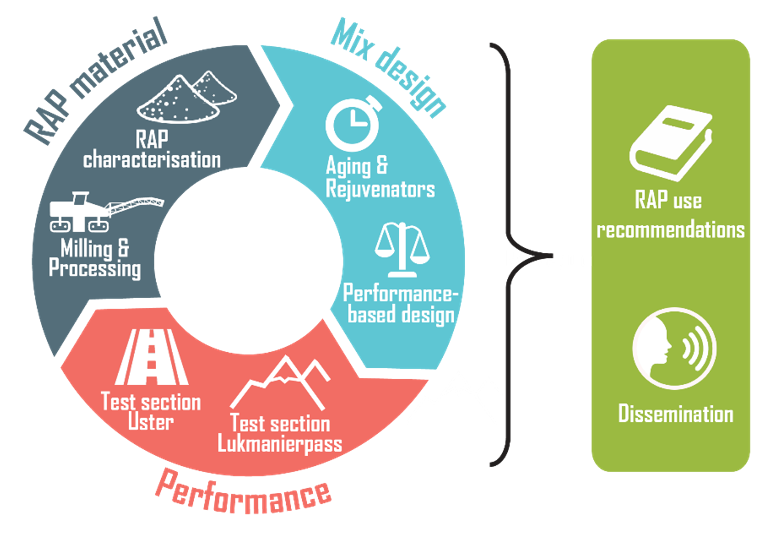Highly Recycled Asphalt Pavement (HighRAP)

Objective
The objective of the HighRAP project was to develop recommendations that would allow increasing the average reclaimed asphalt content in asphalt production without compromising the pavement performance.
Duration: 04.07.2019-31.12.2022
Project Summary
The project addressed three main research topics:
1) RAP Materials
2) Mix design
3) Performance
Within these topics, individual studies addressed the characterization of RAP, improvement of RAP crushing and screening, aging and rejuvenator selection, performance-based mixture design, and construction of two test sites with high RAP content: one in a high traffic road and one at high altitude (1,900 m above sea level).

Project Activities
The HighRAP project tasks and activities for each of the three research directions are shortly summarized below.
|
Study |
Tasks |
Activities during HighRAP project |
|
RAP milling & processing |
Develop RAP processing procedures that allow maximizing the RAP use in production. |
|
|
RAP characterization |
Develop simplified test methods for rapid RAP characterization without extracting binder. |
|
|
Aging & Rejuvenators |
Develop an aging protocol for mixture design to assess durability of rejuvenated RAP. |
|
|
Performance-based mix design |
Develop of a procedure that would allow designing high RAP mixtures with similar performance and life cycle to the conventional asphalt. |
|
|
Test section in Uster |
Evaluate full-scale production and paving of high RAP mixtures for high traffic roads. |
|
|
Test section in Lukmanierpass |
Evaluate full-scale production and paving of high RAP mixtures for high altitude roads. |
|
Publications
|
Project report |
|
|
One-page summary |
|
|
Summary (11 pages) |
|
|
Presentation |
|
|
Calculation tools
|
|
|
Scientific publications |
|
|
Press |
Videos
Project Leader
Team
Lily Poulikakos, Empa
Lukas Boesiger, Ammann Schweiz AG
Bernhard Kunz, BHZ AG
Henry Mazzoni, Catram AG
Peter Bruhin, Catram AG
Dominique Lötscher, Reproad AG
Urs Schellenberg, Kanton Zürich
Chair
Fabian Traber, Bundesamt für Strassen (ASTRA)
Members
David Hiltbrunner, Bundesamt Für Umwelt (BAFU)
Remo Fehr, Amt für Natur und Umwelt - Kanton Graubünden
Dominik Oetiker, Amt für Abfall, Wasser, Energie und Luft – Kanton Zürich
Christoph Gassmann, Baudirektion Kanton ZH Tiefbauamt
Nicolas Bueche, Bern University of Applied Sciences (BFH)
-
Share






